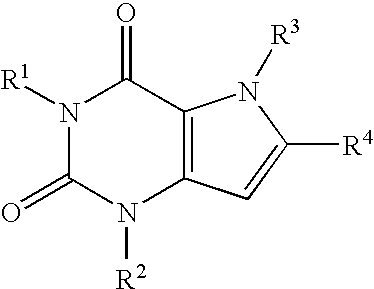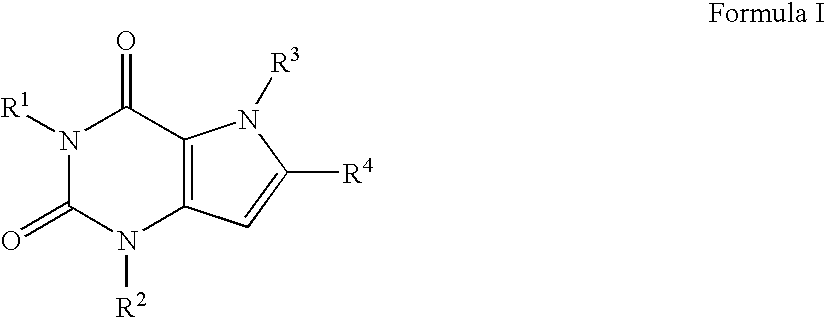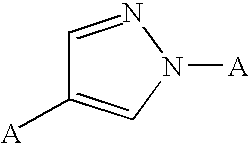A2B adenosine receptor antagonists
a technology of adenosine receptor and adenosine, which is applied in the direction of drug composition, immunological disorders, metabolism disorders, etc., can solve the problems of large plasma levels, potentially fatal complications, and unfavorable blood vessel growth
- Summary
- Abstract
- Description
- Claims
- Application Information
AI Technical Summary
Benefits of technology
Problems solved by technology
Method used
Image
Examples
example 2
Preparation of Compounds of Formula (1b), Wherein R1 and R2 are Identical
[0144] Using the procedure set out in Example 1, but replacing the dipropyl urea with other disubstituted ureas, the following compounds of formula (1b) are prepared: [0145] 1,3,6-triimethyl-1,3-dihydropyrimidine-2,4-dione; [0146] 6-methyl-1,3-diethyl-1,3-dihydropyrimidine-2,4-dione; [0147] 6-methyl-1,3-di(methoxyethyl)-1,3-dihydropyrimidine-2,4-dione; [0148] 6-methyl-1,3-di-n-butyl-1,3-dihydropyrimidine-2,4-dione; [0149] 6-methyl-1,3-diisobutyl-1,3-dihydropyrimidine-2,4-dione; [0150] 6-methyl-1,3-di(phenylethyl)-1,3-dihydropyrimidine-2,4-dione; [0151] 6-methyl-1,3-dicyclobutyl-1,3-dihydropyrimidine-2,4-dione; [0152] 6-methyl-1,3-di(pyrid-4-ylmethyl)-1,3-dihydropyrimidine-2,4-dione; [0153] 6-methyl-1,3-di(furan-3-ylmethyl)-1,3-dihydropyrimidine-2,4-dione; [0154] 6-methyl-1,3-di(4-methoxybenzyl)-1,3-dihydropyrimidine-2,4-dione; [0155] 6-methyl-1,3-di(4-trifluoromethylbenzyl)-1,3-dihydropyrimidine-2,4-dione; and...
example 3
Preparation of a Compound of Formula (1c), 6-Methyl-3-propyl-1,3-dihydropyrimidine-2,4-dione
[0157]
[0158] A suspension of 2,4-dihydroxy-6-methyluracil (20 g, 0.16 mol) and ammonium sulfate (1 g, 0.007 mol, 0.05 eq.) was stirred in HMDS (200 ml) at 130° C. for 16 h, during which time the reaction mixture becomes homogeneous. Excess HMDS was distilled off, and the reaction mixture was cooled to 100° C. To the above residual solution, iodopropane (62 ml, 0.64 mol) was added and the mixture was stirred at 100° C. for 48 h. The reaction mixture was cooled and poured into water. The product was extracted with dichloromethane (3×100 mL). The organic layer was washed with water, brine, and dried over Na2SO4. Removal of solvent gave the product as a solid material, which was washed with ether to get a clean 6-methyl-3-propyl-1,3-dihydropyrimidine-2,4-dione (12 g) and used as such for the next step. The material was characterized by proton and mass spectroscopy.
example 4
Preparation of Compounds of Formula (1c)
[0159] Using the procedure set out in Example 3, but replacing the R1Hal reactants, iodopropane with other halogenated derivatives; the following compounds of formula (1c) are prepared: [0160] 6-methyl-3-ethyl-1,3-dihydropyrimidine-2,4-dione; [0161] 3,6-dimethyl-1,3-dihydropyrimidine-2,4-dione; [0162] 6-methyl-3-methoxy-1,3-dihydropyrimidine-2,4-dione; [0163] 6-methyl-3-n-butyl-1,3-dihydropyrimidine-2,4-dione; [0164] 6-methyl-3-isobutyl-1,3-dihydropyrimidine-2,4-dione; [0165] 6-methyl-3-phenylethyl-1,3-dihydropyrimidine-2,4-dione; [0166] 6-methyl-3-cyclobutyl-1,3-dihydropyrimidine-2,4-dione; [0167] 6-methyl-3-(pyrid-4-ylmethyl)-1,3-dihydropyrimidine-2,4-dione; [0168] 6-methyl-3-(furan-3-ylmethyl)-1,3-dihydropyrimidine-2,4-dione; [0169] 6-methyl-3-(4-methoxybenzyl)-1,3-dihydropyrimidine-2,4-dione; and [0170] 6-methyl-3-(4-fluorobenzyl)-1,3-dihydropyrimidine-2,4-dione.
PUM
| Property | Measurement | Unit |
|---|---|---|
| Structure | aaaaa | aaaaa |
| Disorder | aaaaa | aaaaa |
Abstract
Description
Claims
Application Information
 Login to View More
Login to View More - R&D
- Intellectual Property
- Life Sciences
- Materials
- Tech Scout
- Unparalleled Data Quality
- Higher Quality Content
- 60% Fewer Hallucinations
Browse by: Latest US Patents, China's latest patents, Technical Efficacy Thesaurus, Application Domain, Technology Topic, Popular Technical Reports.
© 2025 PatSnap. All rights reserved.Legal|Privacy policy|Modern Slavery Act Transparency Statement|Sitemap|About US| Contact US: help@patsnap.com



